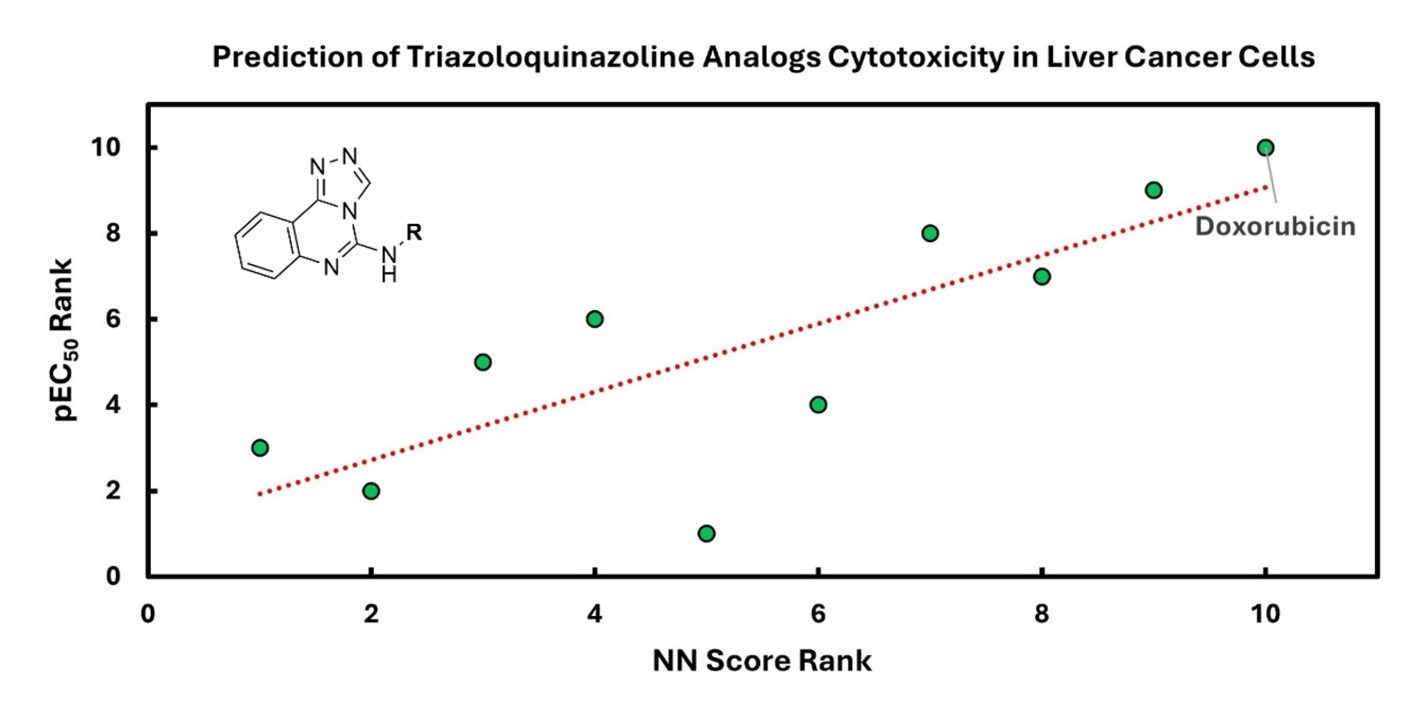Discovery and Basic Research
(T1330-03-15) Prediction of DNA-Targeting Anti-Cancer Therapeutics Using Machine Learning-Guided Molecular Docking
Tuesday, November 11, 2025
1:30 PM - 2:30 PM CT

Dillon Cao, MS
Scientist
Southwest Research Institute
San Antonio, Texas, United States
Dillon Cao, MS
Scientist
Southwest Research Institute
San Antonio, Texas, United States- tA
tristan Adamson, Ph.D.
Research Scientist
Southwest Research Institute
San Antonio, Texas, United States
Presenting Author(s)
Main Author(s)
Co-Author(s)
Purpose: Cancer cells exhibit higher susceptibility to DNA damage compared to healthy cells, making DNA a promising target for novel cancer therapeutics. This research aims to develop and validate a machine learning-guided predictive modeling platform in conjunction with molecular docking for systematically designing and screening DNA-targeting anti-cancer agents.
Methods: The study was divided into three phases: (1) Data curation involved compiling DNA-ligand complex crystal structures from the RCSB Protein Data Bank and categorizing them based on binding modes (intercalation and minor groove binding). Rigorous quality criteria were employed1 to select high-quality structures suitable for virtual screening. (2) Training sets to predict binding affinity and cancer cell cytotoxicity were developed from experimentally validated cellular assay data from publicly accessible databases (e.g., PubChem BioAssays) and peer-reviewed literature. These sets were used to train supervised machine learning models integrated within a customized molecular docking workflow. (3) Validation of these models was performed using external compound sets to evaluate their predictive capabilities for DNA binding affinity and cytotoxicity against various cancer cell lines. Docking-derived scoring metrics such as XScore2, cavity occupation (CAVOC), molecular-weight corrected score (MWSC), and pose population (POP) were used as model inputs. Model performance was assessed using receiver operating characteristic (ROC) curves (quantified by area under the curve, AUC), enrichment factor (EF), and Spearman correlation statistics.
Results: The developed models demonstrated predictive accuracy. Binding affinity models effectively distinguished potent compounds from inactive controls (ROC AUC intercalators = 0.697, minor groove binders = 0.789). The cytotoxicity training models showed statistical correlation for anti-cancer activities across multiple compound classes, including triazolophthalazines analogues3 against MCF-7 breast cancer cells (Spearman coefficient = 0.400, p, two-tailed = 0.0352), triazoloquinazolines analogues4 against HepG2 liver cancer cells (Spearman coefficient = 0.794, p, two-tailed = 0.0061), and duocarmycin SA analogs5,6 against L1210 mouse lymphocytic leukemia cells (Spearman coefficient = 0.594, p, two-tailed = 0.00042).
Conclusion: This study presents a systematic framework for integrating molecular docking with machine learning to model DNA-ligand interactions relevant to cancer therapeutics. The developed workflow demonstrated validated a robust, predictive molecular docking platform that accurately ranks potential DNA-targeting compounds based on binding affinity and anticancer potencies toward leukemia, breast cancer, and liver cancer cells with statistical significance. By developing high-confidence training sets and validating predictive models across multiple compound classes and cancer types, this approach demonstrates feasibility for prioritizing DNA-targeting agents with desirable biological activity. The results highlight the utility of structure-based learning to support rational design and screening in oncology drug discovery.
References: 1) Warren, G. L.; Do, T. D.; Kelley, B. P.; Nicholls, A.; Warren, S. D. Essential Considerations for Using Protein–Ligand Structures in Drug Discovery. Drug Discov. Today 2012, 17 (23), 1270–1281. https://doi.org/10.1016/j.drudis.2012.06.011.
2) Wang, R.; Lai, L.; Wang, S. Further Development and Validation of Empirical Scoring Functions for Structure-Based Binding Affinity Prediction. J. Comput. Aided Mol. Des. 2002, 16 (1), 11–26. https://doi.org/10.1023/A:1016357811882.
3) Sakr, H.; Ayyad, R. R.; El-Helby, A. A.; Khalifa, M. M.; Mahdy, H. A. Discovery of Novel Triazolophthalazine Derivatives as DNA Intercalators and Topoisomerase II Inhibitors. Arch. Pharm. (Weinheim) 2021, 354 (6), 2000456. https://doi.org/10.1002/ardp.202000456.
(4) Eissa, I. H.; Ibrahim, M.-K.; Alesawy, M. S.; El-Adl, K. Antiproliferative Evaluations of Triazoloquinazolines as Classical DNA Intercalators: Design, Synthesis, ADMET Profile, and Molecular Docking. Arch. Pharm. (Weinheim) 2022, 355 (5), 2100487. https://doi.org/10.1002/ardp.202100487.
(5) MacMillan, K. S.; Boger, D. L. Fundamental Relationships between Structure, Reactivity, and Biological Activity for the Duocarmycins and CC-1065. J. Med. Chem. 2009, 52 (19), 5771–5780. https://doi.org/10.1021/jm9006214.
(6) Robertson, W. M.; Kastrinsky, D. B.; Hwang, I.; Boger, D. L. Synthesis and Evaluation of a Series of C5′-Substituted Duocarmycin SA Analogs. Bioorg. Med. Chem. Lett. 2010, 20 (9), 2722–2725. https://doi.org/10.1016/j.bmcl.2010.03.078.
Acknowledgements: This research was conducted by Southwest Research Institute under SwRI project # R6443: Development of an In Silico DNA-Reactive Anticancer Therapeutic Virtual Screening Platform Using SwRI-Developed Rhodium(TM) Docking Software.
 Figure 1. Flow chart of the molecular docking workflow used in this research, training using supervised machine learning, and predicting the activities of small molecule drug targets. The box area represents the programmable “machine.” Arrows illustrate the different weights that are applied to each variable in the neural network. The XScore level represents the docking-derived machine inputs (XSCORE, CAVOC, MWSC, and POP). Model performance was assessed using receiver operating characteristic (ROC). The Training Set level represents the inputs which are weighted based on user generated training labels (active or inactive). Finally, the neural network can be applied to activity predictions.
Figure 1. Flow chart of the molecular docking workflow used in this research, training using supervised machine learning, and predicting the activities of small molecule drug targets. The box area represents the programmable “machine.” Arrows illustrate the different weights that are applied to each variable in the neural network. The XScore level represents the docking-derived machine inputs (XSCORE, CAVOC, MWSC, and POP). Model performance was assessed using receiver operating characteristic (ROC). The Training Set level represents the inputs which are weighted based on user generated training labels (active or inactive). Finally, the neural network can be applied to activity predictions.
 Figure 2. Spearman correlation of rank-ordered predicted (NN Score Rank) vs experimental (pEC50 Rank) Hep G2 cytotoxicity for a series of 9 triazolopthalazine analogs.
Figure 2. Spearman correlation of rank-ordered predicted (NN Score Rank) vs experimental (pEC50 Rank) Hep G2 cytotoxicity for a series of 9 triazolopthalazine analogs.
 Figure 3. ROC curve demonstrating the true positive rate vs false positive rate when using our developed training sets to predict the cancer cell cytotoxicity of a series of 31 duocarmycin SA analogs against leukemia cancer cells (L1210).
Figure 3. ROC curve demonstrating the true positive rate vs false positive rate when using our developed training sets to predict the cancer cell cytotoxicity of a series of 31 duocarmycin SA analogs against leukemia cancer cells (L1210).
Methods: The study was divided into three phases: (1) Data curation involved compiling DNA-ligand complex crystal structures from the RCSB Protein Data Bank and categorizing them based on binding modes (intercalation and minor groove binding). Rigorous quality criteria were employed1 to select high-quality structures suitable for virtual screening. (2) Training sets to predict binding affinity and cancer cell cytotoxicity were developed from experimentally validated cellular assay data from publicly accessible databases (e.g., PubChem BioAssays) and peer-reviewed literature. These sets were used to train supervised machine learning models integrated within a customized molecular docking workflow. (3) Validation of these models was performed using external compound sets to evaluate their predictive capabilities for DNA binding affinity and cytotoxicity against various cancer cell lines. Docking-derived scoring metrics such as XScore2, cavity occupation (CAVOC), molecular-weight corrected score (MWSC), and pose population (POP) were used as model inputs. Model performance was assessed using receiver operating characteristic (ROC) curves (quantified by area under the curve, AUC), enrichment factor (EF), and Spearman correlation statistics.
Results: The developed models demonstrated predictive accuracy. Binding affinity models effectively distinguished potent compounds from inactive controls (ROC AUC intercalators = 0.697, minor groove binders = 0.789). The cytotoxicity training models showed statistical correlation for anti-cancer activities across multiple compound classes, including triazolophthalazines analogues3 against MCF-7 breast cancer cells (Spearman coefficient = 0.400, p, two-tailed = 0.0352), triazoloquinazolines analogues4 against HepG2 liver cancer cells (Spearman coefficient = 0.794, p, two-tailed = 0.0061), and duocarmycin SA analogs5,6 against L1210 mouse lymphocytic leukemia cells (Spearman coefficient = 0.594, p, two-tailed = 0.00042).
Conclusion: This study presents a systematic framework for integrating molecular docking with machine learning to model DNA-ligand interactions relevant to cancer therapeutics. The developed workflow demonstrated validated a robust, predictive molecular docking platform that accurately ranks potential DNA-targeting compounds based on binding affinity and anticancer potencies toward leukemia, breast cancer, and liver cancer cells with statistical significance. By developing high-confidence training sets and validating predictive models across multiple compound classes and cancer types, this approach demonstrates feasibility for prioritizing DNA-targeting agents with desirable biological activity. The results highlight the utility of structure-based learning to support rational design and screening in oncology drug discovery.
References: 1) Warren, G. L.; Do, T. D.; Kelley, B. P.; Nicholls, A.; Warren, S. D. Essential Considerations for Using Protein–Ligand Structures in Drug Discovery. Drug Discov. Today 2012, 17 (23), 1270–1281. https://doi.org/10.1016/j.drudis.2012.06.011.
2) Wang, R.; Lai, L.; Wang, S. Further Development and Validation of Empirical Scoring Functions for Structure-Based Binding Affinity Prediction. J. Comput. Aided Mol. Des. 2002, 16 (1), 11–26. https://doi.org/10.1023/A:1016357811882.
3) Sakr, H.; Ayyad, R. R.; El-Helby, A. A.; Khalifa, M. M.; Mahdy, H. A. Discovery of Novel Triazolophthalazine Derivatives as DNA Intercalators and Topoisomerase II Inhibitors. Arch. Pharm. (Weinheim) 2021, 354 (6), 2000456. https://doi.org/10.1002/ardp.202000456.
(4) Eissa, I. H.; Ibrahim, M.-K.; Alesawy, M. S.; El-Adl, K. Antiproliferative Evaluations of Triazoloquinazolines as Classical DNA Intercalators: Design, Synthesis, ADMET Profile, and Molecular Docking. Arch. Pharm. (Weinheim) 2022, 355 (5), 2100487. https://doi.org/10.1002/ardp.202100487.
(5) MacMillan, K. S.; Boger, D. L. Fundamental Relationships between Structure, Reactivity, and Biological Activity for the Duocarmycins and CC-1065. J. Med. Chem. 2009, 52 (19), 5771–5780. https://doi.org/10.1021/jm9006214.
(6) Robertson, W. M.; Kastrinsky, D. B.; Hwang, I.; Boger, D. L. Synthesis and Evaluation of a Series of C5′-Substituted Duocarmycin SA Analogs. Bioorg. Med. Chem. Lett. 2010, 20 (9), 2722–2725. https://doi.org/10.1016/j.bmcl.2010.03.078.
Acknowledgements: This research was conducted by Southwest Research Institute under SwRI project # R6443: Development of an In Silico DNA-Reactive Anticancer Therapeutic Virtual Screening Platform Using SwRI-Developed Rhodium(TM) Docking Software.
 Figure 1. Flow chart of the molecular docking workflow used in this research, training using supervised machine learning, and predicting the activities of small molecule drug targets. The box area represents the programmable “machine.” Arrows illustrate the different weights that are applied to each variable in the neural network. The XScore level represents the docking-derived machine inputs (XSCORE, CAVOC, MWSC, and POP). Model performance was assessed using receiver operating characteristic (ROC). The Training Set level represents the inputs which are weighted based on user generated training labels (active or inactive). Finally, the neural network can be applied to activity predictions.
Figure 1. Flow chart of the molecular docking workflow used in this research, training using supervised machine learning, and predicting the activities of small molecule drug targets. The box area represents the programmable “machine.” Arrows illustrate the different weights that are applied to each variable in the neural network. The XScore level represents the docking-derived machine inputs (XSCORE, CAVOC, MWSC, and POP). Model performance was assessed using receiver operating characteristic (ROC). The Training Set level represents the inputs which are weighted based on user generated training labels (active or inactive). Finally, the neural network can be applied to activity predictions. Figure 2. Spearman correlation of rank-ordered predicted (NN Score Rank) vs experimental (pEC50 Rank) Hep G2 cytotoxicity for a series of 9 triazolopthalazine analogs.
Figure 2. Spearman correlation of rank-ordered predicted (NN Score Rank) vs experimental (pEC50 Rank) Hep G2 cytotoxicity for a series of 9 triazolopthalazine analogs. Figure 3. ROC curve demonstrating the true positive rate vs false positive rate when using our developed training sets to predict the cancer cell cytotoxicity of a series of 31 duocarmycin SA analogs against leukemia cancer cells (L1210).
Figure 3. ROC curve demonstrating the true positive rate vs false positive rate when using our developed training sets to predict the cancer cell cytotoxicity of a series of 31 duocarmycin SA analogs against leukemia cancer cells (L1210).